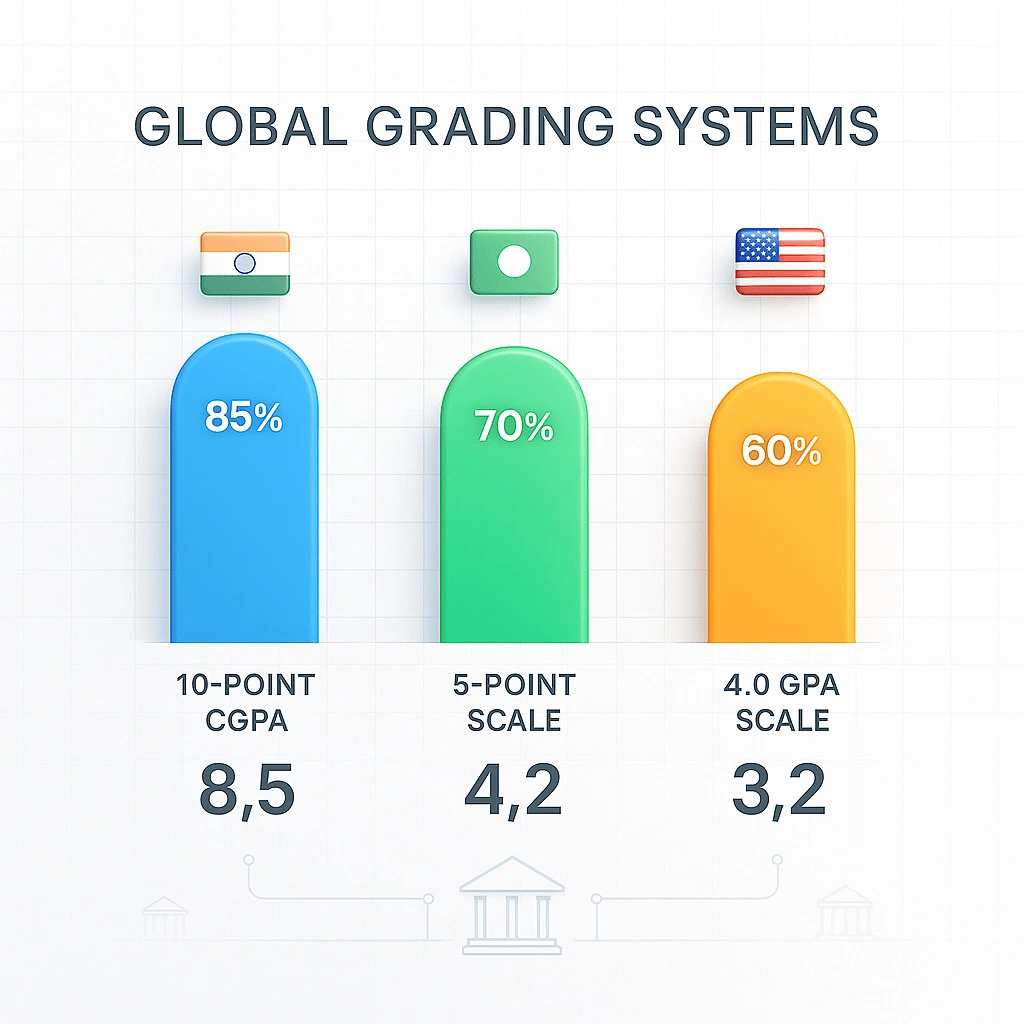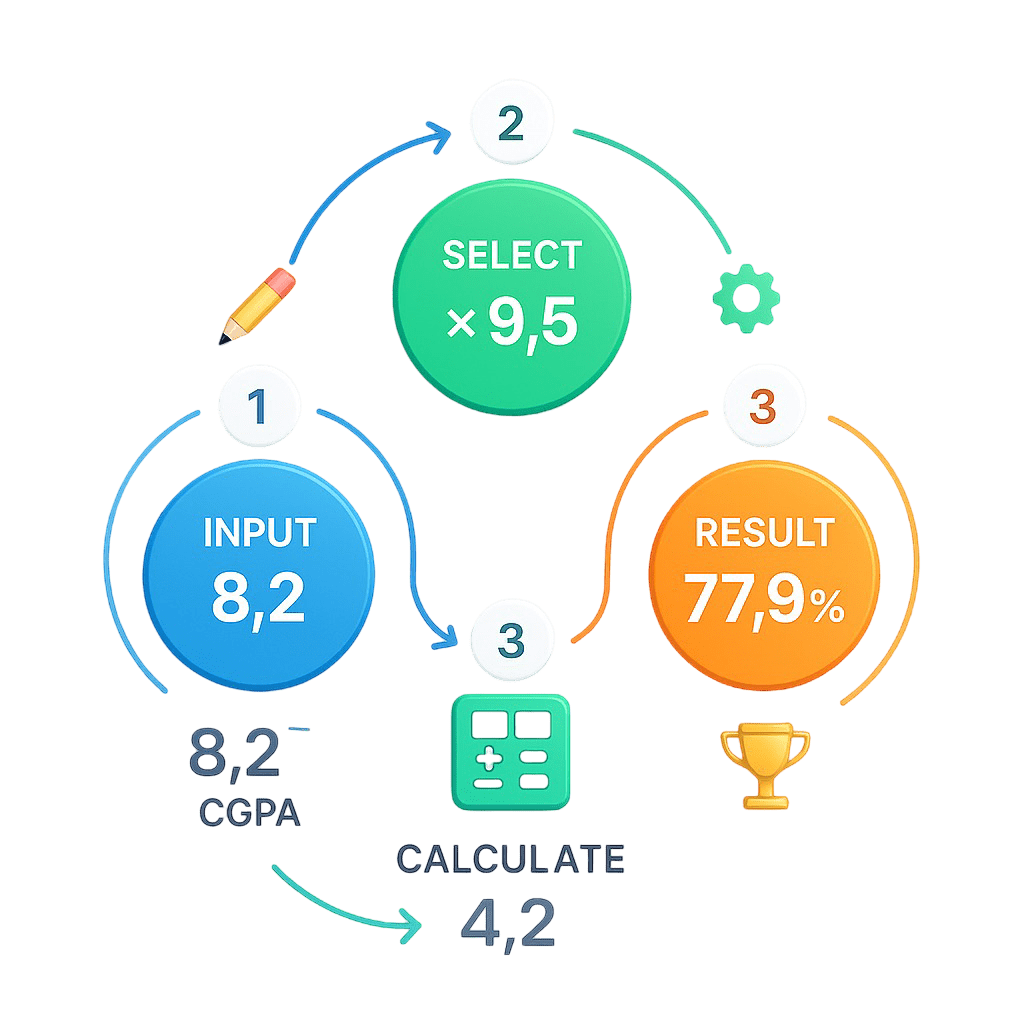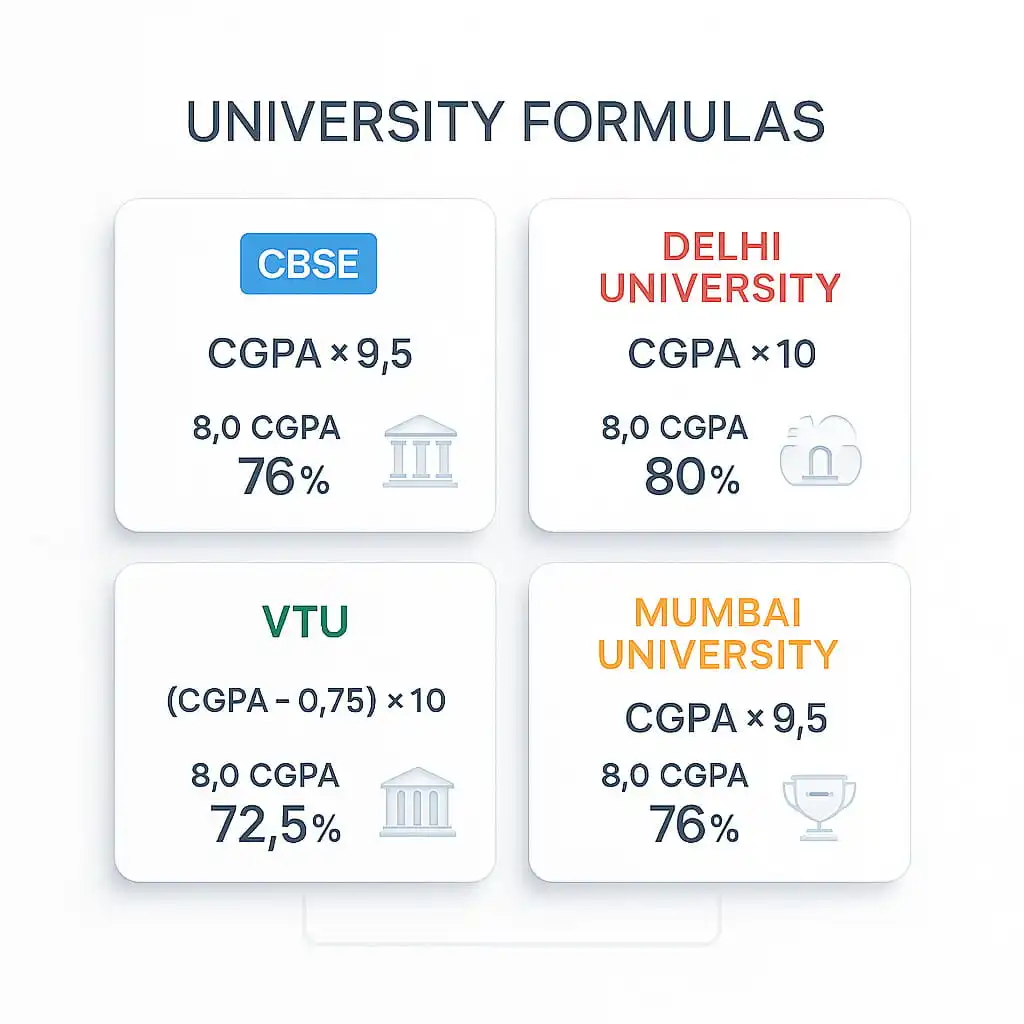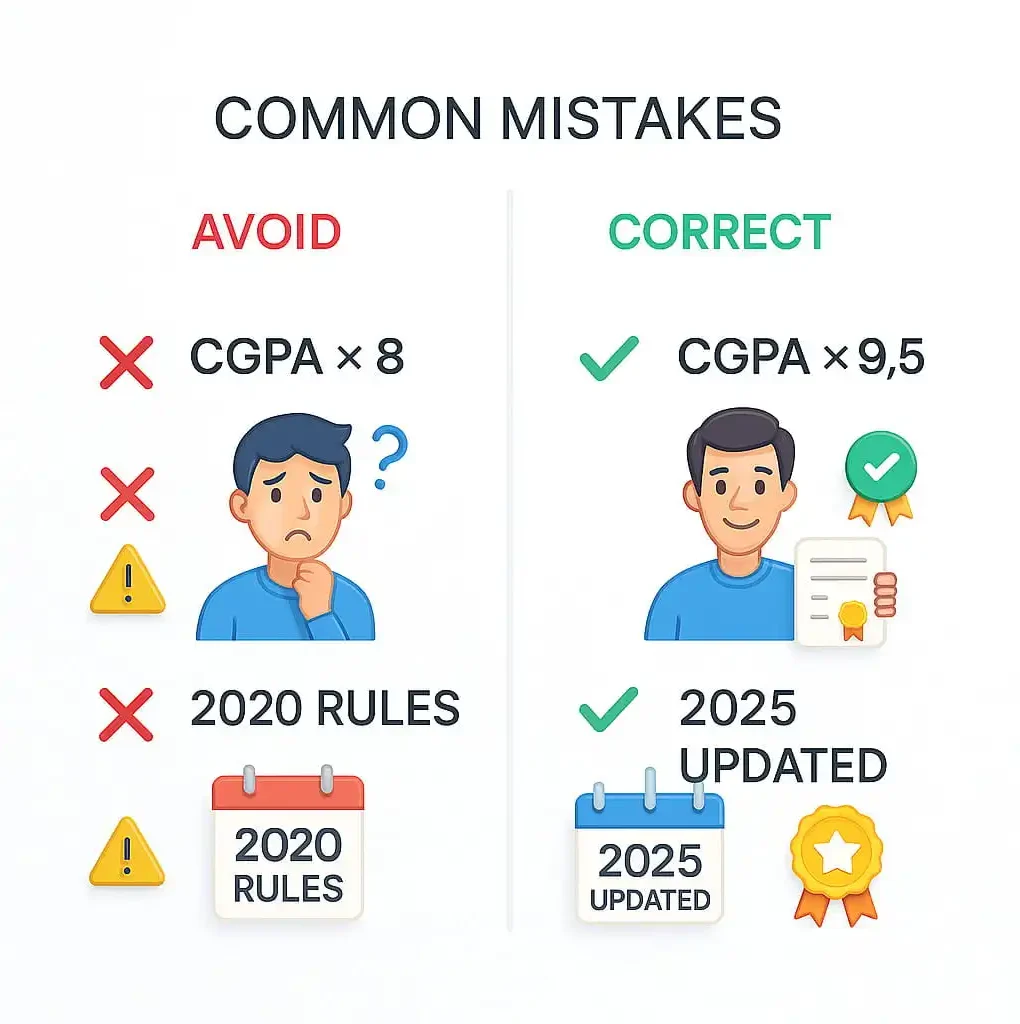CGPA to Percentage Calculator
| Sr. No. | CGPA | Percentage | College | Scale |
|---|
The Most Accurate CGPA to Percentage Converter (Perfect for 10, 5 and 4-Point Scales)
Converting your CGPA to percentage isn’t just a numbers game, it’s essential. From college admissions to Government job (Sarkari job) forms, even scholarship eligibility, you’ll need the right numbers in the right format.
But here’s the problem: not all universities follow the same rule. Some use CGPA × 9.5. Others go with ×10. Boards like CBSE, universities like DU, MU, VTU, and global systems like the 4.0 scale CGPA, they all differ.
That’s why we built this most accurate CGPA to percentage calculator. It’s free, fast, and mobile-friendly, built to reflect UGC/AICTE guidelines, university-specific methods like AKTU, MAKAUT, and real-world formulas like (CGPA – 0.75) × 10.


What is CGPA? Understanding the Indian and Global Grading Systems
What is CGPA?
CGPA vs GPA and Global Grading Scales Explained
If you’re applying for higher education abroad, submitting marks for WES evaluation, or qualifying for scholarship eligibility, always verify which academic grading system your destination country accepts.
Why Convert CGPA to Percentage? (Real-World Use Cases & Benefits)
This is exactly why converting your CGPA to percentage isn’t just helpful, it’s often required. From government recruitment forms to AICTE-approved institutions, most ask for your score in percentage format. But beyond conversions, also focus on study tools to improve CGPA for better future results.
Even in the private sector, resume grade conversion is a smart strategy. Students can leverage Android apps to boost CGPA while maintaining accurate conversion records. Recruiters, especially for technical or PSU roles, often compare candidates using percentage cutoffs during shortlisting.
How to Convert CGPA to Percentage: Step-by-Step (With Multiple Formulas)
Even in the private sector, resume grade conversion is a smart strategy. Recruiters, especially for technical or PSU roles, often compare candidates using percentage cutoffs during shortlisting.

Step-by-Step Conversion Using the Standard UGC Rule (×9.5)
CGPA × 9.5 = Percentage
8.0 × 9.5 = 76%
Delhi University (DU) and Other Custom Formulas (×10 Rule)
CGPA × 10 = Percentage
How to Use Our CGPA to Percentage Calculator (Fast, Free & Accurate)
- Select Your Grading Scale: Choose from 10-point CGPA scale, 5.0 scale, or 4.0 CGPA scale, based on your board or university system.
- Enter Your CGPA: Type your CGPA (Cumulative Grade Point Average) into the input field. Supports full and decimal values.
- Get Instant Percentage Results: Hit “Convert” to view your percentage equivalent immediately, powered by the correct conversion formula for your scale.
- Try Multiple Scenarios Without Reloading: Use “Reset” to start over instantly. Ideal for resume grade conversion, form submissions, or WES evaluation.
- Fully Mobile-Responsive & Free: This online CGPA to percentage calculator works seamlessly across devices, no logins or downloads needed.

CGPA Conversion by University and Board (India, Pakistan, Nepal)
Below is a breakdown of official practices across major Indian institutions and neighboring countries, with tips on how to verify your board’s policy and request a conversion certificate if needed.
CBSE / UGC / NAAC Guidelines (×9.5)
Boards following CBSE, and universities aligned with UGC and NAAC, recommend CGPA × 9.5 as the standard method, rooted in percentile research dating back to CBSE’s grading shift in 2009.
Delhi University (×10 – Updated)
Mumbai University (DU vs MU % Conflict)
VTU, Anna, KTU, GTU & Others
Technical universities like VTU, Anna University, GTU, and KTU use unique formulas like (CGPA − 0.75) × 10 or CGPA × 9.25, as stated in their internal grading regulations.
Pakistan & Nepal – Country-Based Rules
Pakistan
- For a 4-point system, the formula is: Percentage = (CGPA ÷ 4) × 100
- For a 5-point system, it’s: Percentage = (CGPA ÷ 5) × 100
Nepal
- Conversion methods vary, some use simple multipliers, others use division-based formulas.
- For example, Pokhara University follows the scaling approved in the 13th Academic Council (2062 BS)
CGPA to Percentage Conversion Table
CGPA To Percentage in 10 Grade Points
| CGPA (10 Grade) | Percentage in 10 Grade Scale |
|---|---|
| 10.0 CGPA in percentage | 95%-100% |
| 9.9 CGPA in percentage | 94.05% |
| 9.8 CGPA in percentage | 93.10% |
| 9.7 CGPA in percentage | 92.15% |
| 9.6 CGPA in percentage | 91.20% |
| 9.5 CGPA in percentage | 90.25% |
| 9.4 CGPA in percentage | 89.30% |
| 9.3 CGPA in percentage | 88.35% |
| 9.2 CGPA in percentage | 87.40% |
| 9.1 CGPA in percentage | 86.45% |
| 9.0 CGPA in percentage | 85.50% |
| 8.9 CGPA in percentage | 84.55% |
| 8.8 CGPA in percentage | 83.60% |
| 8.7 CGPA in percentage | 82.65% |
| 8.6 CGPA in percentage | 81.70% |
| 8.5 CGPA in percentage | 80.75% |
| 8.4 CGPA in percentage | 79.80% |
| 8.3 CGPA in percentage | 78.85% |
| 8.2 CGPA in percentage | 77.90% |
| 8.1 CGPA in percentage | 76.95% |
| 8.0 CGPA in percentage | 76% |
| 7.9 CGPA in percentage | 75.05% |
| 7.8 CGPA in percentage | 74.10% |
| 7.7 CGPA in percentage | 73.15% |
| 7.6 CGPA in percentage | 72.20% |
| 7.5 CGPA in percentage | 71.25% |
| 7.4 CGPA in percentage | 70.30% |
| 7.3 CGPA in percentage | 69.35% |
| 7.2 CGPA in percentage | 68.40% |
| 7.1 CGPA in percentage | 67.45% |
| 7.0 CGPA in percentage | 66.50% |
| 6.9 CGPA in percentage | 65.55% |
| 6.8 CGPA in percentage | 64.60% |
| 6.7 CGPA in percentage | 63.65% |
| 6.6 CGPA in percentage | 62.70% |
| 6.5 CGPA in percentage | 61.75% |
| 6.4 CGPA in percentage | 60.80% |
| 6.3 CGPA in percentage | 59.85% |
| 6.2 CGPA in percentage | 58.90% |
| 6.1 CGPA in percentage | 57.95% |
| 6.0 CGPA in percentage | 57% |
| 5.9 CGPA in percentage | 56.05% |
| 5.8 CGPA in percentage | 55.10% |
| 5.7 CGPA in percentage | 54.15% |
| 5.6 CGPA in percentage | 53.20% |
| 5.5 CGPA in percentage | 52.25% |
| 5.4 CGPA in percentage | 51.30% |
| 5.3 CGPA in percentage | 50.35% |
| 5.2 CGPA in percentage | 49.40% |
| 5.1 CGPA in percentage | 48.45% |
| 5.0 CGPA in percentage | 47.50% |
| 4.9 CGPA in percentage | 46.55% |
| 4.8 CGPA in percentage | 45.60% |
| 4.7 CGPA in percentage | 44.65% |
| 4.6 CGPA in percentage | 43.70% |
| 4.5 CGPA in percentage | 42.75% |
| 4.4 CGPA in percentage | 41.80% |
| 4.3 CGPA in percentage | 40.85% |
| 4.2 CGPA in percentage | 39.90% |
| 4.1 CGPA in percentage | 38.95% |
| 4.0 CGPA in percentage | 38% |
| 3.9 CGPA in percentage | 37.05% |
| 3.8 CGPA in percentage | 36.10% |
| 3.7 CGPA in percentage | 35.15% |
| 3.6 CGPA in percentage | 34.20% |
| 3.5 CGPA in percentage | 33.25% |
| 3.4 CGPA in percentage | 32.30% |
| 3.3 CGPA in percentage | 31.35% |
| 3.2 CGPA in percentage | 30.40% |
| 3.1 CGPA in percentage | 29.45% |
| 3.0 CGPA in percentage | 28.50% |
CGPA To Percentage in 5 Grade Scale
| CGPA | Percentage in 5 grade scale |
|---|---|
| 0.0 CGPA in percentage (5 Grade Points) | 0% |
| 0.1 CGPA in percentage (5 Grade Points) | 2% |
| 0.2 CGPA in percentage (5 Grade Points) | 4% |
| 0.3 CGPA in percentage (5 Grade Points) | 6% |
| 0.4 CGPA in percentage (5 Grade Points) | 8% |
| 0.5 CGPA in percentage (5 Grade Points) | 10% |
| 0.6 CGPA in percentage (5 Grade Points) | 12% |
| 0.7 CGPA in percentage (5 Grade Points) | 14% |
| 0.8 CGPA in percentage (5 Grade Points) | 16% |
| 0.9 CGPA in percentage (5 Grade Points) | 18% |
| 1.0 CGPA in percentage (5 Grade Points) | 20% |
| 1.1 CGPA in percentage (5 Grade Points) | 22% |
| 1.2 CGPA in percentage (5 Grade Points) | 24% |
| 1.3 CGPA in percentage (5 Grade Points) | 26% |
| 1.4 CGPA in percentage (5 Grade Points) | 28% |
| 1.5 CGPA in percentage (5 Grade Points) | 30% |
| 1.6 CGPA in percentage (5 Grade Points) | 32% |
| 1.7 CGPA in percentage (5 Grade Points) | 34% |
| 1.8 CGPA in percentage (5 Grade Points) | 36% |
| 1.9 CGPA in percentage (5 Grade Points) | 38% |
| 2.0 CGPA in percentage (5 Grade Points) | 40% |
| 2.1 CGPA in percentage (5 Grade Points) | 42% |
| 2.2 CGPA in percentage (5 Grade Points) | 44% |
| 2.3 CGPA in percentage (5 Grade Points) | 46% |
| 2.4 CGPA in percentage (5 Grade Points) | 48% |
| 2.5 CGPA in percentage (5 Grade Points) | 50% |
| 2.6 CGPA in percentage (5 Grade Points) | 52% |
| 2.7 CGPA in percentage (5 Grade Points) | 54% |
| 2.8 CGPA in percentage (5 Grade Points) | 56% |
| 2.9 CGPA in percentage (5 Grade Points) | 58% |
| 3.0 CGPA in percentage (5 Grade Points) | 60% |
| 3.1 CGPA in percentage (5 Grade Points) | 62% |
| 3.2 CGPA in percentage (5 Grade Points) | 64% |
| 3.3 CGPA in percentage (5 Grade Points) | 66% |
| 3.4 CGPA in percentage (5 Grade Points) | 68% |
| 3.5 CGPA in percentage (5 Grade Points) | 70% |
| 3.6 CGPA in percentage (5 Grade Points) | 72% |
| 3.7 CGPA in percentage (5 Grade Points) | 74% |
| 3.8 CGPA in percentage (5 Grade Points) | 76% |
| 3.9 CGPA in percentage (5 Grade Points) | 78% |
| 4.0 CGPA in percentage (5 Grade Points) | 80% |
| 4.1 CGPA in percentage (5 Grade Points) | 82% |
| 4.2 CGPA in percentage (5 Grade Points) | 84% |
| 4.3 CGPA in percentage (5 Grade Points) | 86% |
| 4.4 CGPA in percentage (5 Grade Points) | 88% |
| 4.5 CGPA in percentage (5 Grade Points) | 90% |
| 4.6 CGPA in percentage (5 Grade Points) | 92% |
| 4.7 CGPA in percentage (5 Grade Points) | 94% |
| 4.8 CGPA in percentage (5 Grade Points) | 96% |
| 4.9 CGPA in percentage (5 Grade Points) | 98% |
| 5.0 CGPA in percentage (5 Grade Points) | 100% |
CGPA To Percentage in 4 Grade Scale
| CGPA | Percentage in 4 Grade Scale |
|---|---|
| 0.0 CGPA in percentage | 0% |
| 0.1 CGPA in percentage | 2.5% |
| 0.2 CGPA in percentage | 5% |
| 0.3 CGPA in percentage | 7.5% |
| 0.4 CGPA in percentage | 10% |
| 0.5 CGPA in percentage | 12.5% |
| 0.6 CGPA in percentage | 15% |
| 0.7 CGPA in percentage | 17.5% |
| 0.8 CGPA in percentage | 20% |
| 0.9 CGPA in percentage | 22.5% |
| 1.0 CGPA in percentage | 25% |
| 1.1 CGPA in percentage | 27.5% |
| 1.2 CGPA in percentage | 30% |
| 1.3 CGPA in percentage | 32.5% |
| 1.4 CGPA in percentage | 35% |
| 1.5 CGPA in percentage | 37.5% |
| 1.6 CGPA in percentage | 40% |
| 1.7 CGPA in percentage | 42.5% |
| 1.8 CGPA in percentage | 45% |
| 1.9 CGPA in percentage | 47.5% |
| 2.0 CGPA in percentage | 50% |
| 2.1 CGPA in percentage | 52.5% |
| 2.2 CGPA in percentage | 55% |
| 2.3 CGPA in percentage | 57.5% |
| 2.4 CGPA in percentage | 60% |
| 2.5 CGPA in percentage | 62.5% |
| 2.6 CGPA in percentage | 65% |
| 2.7 CGPA in percentage | 67.5% |
| 2.8 CGPA in percentage | 70% |
| 2.9 CGPA in percentage | 72.5% |
| 3.0 CGPA in percentage | 75% |
| 3.1 CGPA in percentage | 77.5% |
| 3.2 CGPA in percentage | 80% |
| 3.3 CGPA in percentage | 82.5% |
| 3.4 CGPA in percentage | 85% |
| 3.5 CGPA in percentage | 87.5% |
| 3.6 CGPA in percentage | 90% |
| 3.7 CGPA in percentage | 92.5% |
| 3.8 CGPA in percentage | 95% |
| 3.9 CGPA in percentage | 97.5% |
| 4.0 CGPA in percentage | 100% |
CGPA vs GPA vs SGPA: What’s the Difference?
CGPA vs GPA — Cumulative vs Semester Focus
SGPA vs CGPA — Semester Focus vs Program-Wide Average
SGPA (Seasonal/Session Grade Point Average) reflects your grades in a specific semester, which you can calculate using our dedicated tool. For example, a student might have an 8.5 SGPA in semester 3, but a 7.9 CGPA overall.
SGPA vs GPA — Local vs Global Semester Systems
Common Mistakes When Converting CGPA to Percentage
- Using the Wrong University Formula: Not all institutions use CGPA × 9.5. Some require CGPA × 10, (CGPA − 0.75) × 10, or unique scales. Check your board or university’s official circular.
- Referring to Outdated Guidelines (e.g., DU’s Old Rule): Some students still use Delhi University’s pre-2021 multiplier. Always confirm current conversion logic through DU’s academic regulation portal.
- Submitting Unofficial Conversions: Manually typed percentages without an attested CGPA to percentage certificate may be rejected by universities or employers.
- Confusing SGPA, CGPA, and GPA: Using SGPA (semester score) or GPA (international scale) in place of CGPA for final percentage conversion leads to inflated or incorrect results.
- Misusing Online Tools: Not all online tools are accurate. Many don’t support board-specific formulas, leading to wrong conversions. Always use a calculator that allows grading scale selection.

Conclusion
FAQ’s
10 CGPA equals 100% on most Indian 10-point grading systems because the formula is CGPA × 10 or CGPA × 9.5, depending on your institution. Always check if your board uses CBSE formula (×9.5) or DU formula (×10) for an official conversion.
